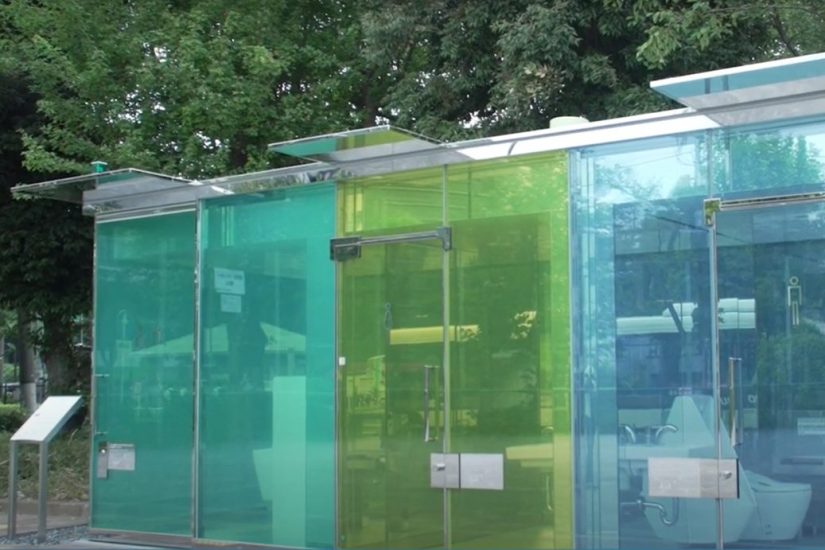Even in Japan with its well-developed sanitary facilities this public toilet and hand-washing device are surprising
Japan receives much rainfall and has lush forests, so water is abundantly available. For that reason, as previously introduced, technology related to sanitary facilities such as toilets has also developed in its own distinctive way.
Even in Japan, where sophisticated sanitary facilities have become familiar and widespread, sometimes something surprisingly innovative appears. This time, I would like to introduce a currently topical public toilet and hand-washing device.
Public toilet walls that become transparent to guarantee safety
Because toilets are extremely private spaces, the interior cannot be seen at all from the outside. However, two public toilets, newly set up in a park in Tokyo’s Shibuya district, have walls that become transparent so that one can clearly see inside. Seeing is believing, so first take a look at the official websites of the toilets at Yoyogi Fukamachi Mini Park and Haru-No-Ogawa Community Park.
These two toilets were created as part of “The Tokyo Toilet”; a new public toilet installation project by the Nippon Foundation, which wanted to make public toilets more comfortable to use. The innovative and beautiful design is not meant to look quirky.By making the walls transparent, you can check at a glance from the outside whether or not it has been properly cleaned, and whether anyone is hiding inside. In this way, the toilet can be used comfortably and safely.
Naturally, there is a mechanism provided which hides the interior as needed. Once someone has entered the toilet and locked it, the transparent walls are transformed into frosted glass so that the interior cannot be seen from outside, just like a regular toilet. A sheet of polymer dispersed liquid crystal (PDLC) is sandwiched between the glass surfaces of the walls. Depending on whether or not an electric current is passed through this PDLC sheet, the wall can be made transparent or opaque as required.
When the toilet is unlocked, an electric current makes the wall transparent, making it obvious that the toilet is unoccupied. On entering the toilet and locking the door, the current stops, the wall becomes opaque, and the toilet can be used. This system ensures that even if there is a power cut, the opaque state will be maintained while the toilet is in use…
A COVID-19 countermeasure that allows you to wash your hands without water
As one of the measures against the new coronavirus (COVID-19), hand-washing is a relatively simple action that is known to be highly effective. However, at locations which do not have easy access to a regular water supply, it is difficult to provide a large quantity of the sanitary water indispensable for hand-washing. Even in a city like Tokyo, stores such as clothing boutiques and bookshops do not have a ready water supply at their storefront, so customers cannot wash their hands.
At such stores in Tokyo’s Ginza district, a hand-washing stand called WOSH by WOTA has begun to be used. This can be installed anywhere that an electric current can be maintained.
WOSH is a device which functions as an independent water supply system.By connecting to a power source, and adding an initial 20 liters of water, you can use it to wash your hands on the spot. Wastewater resulting from hand washing is treated inside WOSH with filtration, chlorination, and UV rays, after which it can be reused for hand washing. The water quality after treatment is safe as it meets general guidelines for drinking water including those of WHO.
Water is dispensed automatically by holding your hand over the faucet, so you can wash your hands without touching anything, making it more hygenic. Not only water but liquid soap (if replenished) will be dispensed automatically. As the treated water is soft water, the soap foams easily and is easily washed off. Furthermore, to encourage a proper 30-second hand wash, on beginning to wash your hands a timer will appear on the top of the stand and brightly time your wash.
Not only that, but on top of the WOSH is a slot for your smartphone. As you wash your hands, this slot will irradiate your smartphone with UV rays and neutralize any bacteria and viruses on the smartphone’s surface. After all, even if you wash your hands, it is pointless if you then touch a dirty smartphone screen.
In an age when we cannot be parted from our smartphones, WOSH, which can sterilize our smartphone as we wash our hands, is an indispensable sanitary facility.








